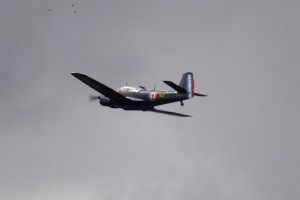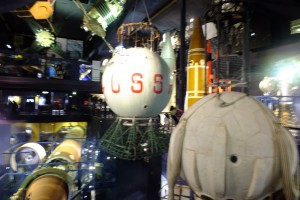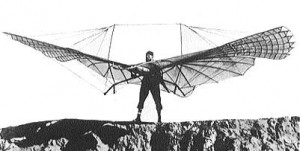
Pilots pose in front of a mono-wing
Le Bourget is rarely mentioned in tourist guides to Paris. In fact, it is better known as a private airport receiving business passengers and chartered flights. This inconspicuous airport however has a rich history and a flight museum, which is fascinating for anyone who has ever had any curiosity about the history of flight and how man took to the air. Peter Campbell reports:
On 13 July 2014, Le Bourget celebrated its centenary. The airfield which was the first commercial aeroport, opened in France in 1919, but was initially opened just weeks before the start of the First World War and only a couple of weeks after Archduke Ferdinand of Austro-Hungary got shot on 28 June 1914.
To celebrate a century of flight Aeroclub de France organised a spectacular air show tracing the history of the flight including dogfights and displays of aircraft from the First World War to today – making a perfect showcase to experience the changes in aircraft design and development over the past century.
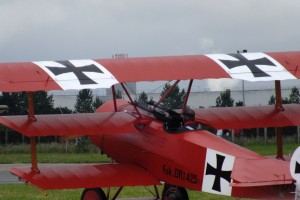
The Fokker Dr I was flown by the Red Baron, Manfred von Richthofen
The airshow began with dogfights between a range of early aircraft including the typical bi-planes and tri-planes. A Fokker Dr I was perhaps one of the most interesting planes to see in action. This aircraft was made famous by Manfred von Richthofen – the war’s most successful pilot with 80 kills, and known for his bright red tri-plane. Richthofen received the nickname “The Red Baron” for his distinctively painted red plane. Commanding the elite Jasta 11 squadron, consisting of other notable German aces, the unit was known as the flying circus as they painted their planes a variety of colours and took gypsy caravans with them when moving base.
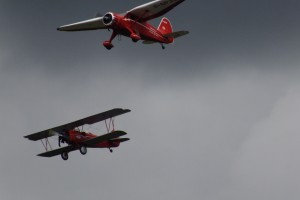
Aircraft in formation
They may similarly have earned the name from their aerial acrobatics but their clowning didn’t earn them many laughs – especially among Allied pilots. Although the Fokker is the most recognisable of the Red Baron’s planes, he only made 19 kills in it, and it was the in the Fokker that Richthofen was eventually killed. Indeed, the Baron had become such a distinctive hero the allies put a bounty on his head and offered an automatic Victoria Cross to any flyer who succeeded in shooting him down.
Richthofen was eventually killed in a dogfight with two Canadian pilots. He was wounded by a single .303 round to the chest and died shortly after landing his plane near Australian forces in the Somme.
Richthofen’s brother was also a successful fighter ace and survived the war, only to be killed in 1922 in an civil aviation accident – his two passengers survived the accident.
World War II planes take central stage
After several displays of WWI aircraft the airshow moved onto some of the more famous World War II aircraft including a Hawker Hurricane, Spitfire and Yak. The Hurricanes and Spitfires were produced shortly before the war in 1937 and 1938 respectively and had a maximum speed of 515 and 570 km/h. These two aircraft were used extensively by the Royal Airforce during WWII and were Britain’s main defence in the Battle for Britain.
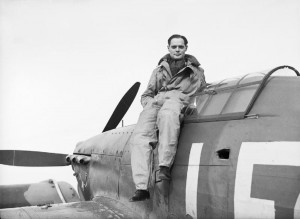
Sir Douglas Bader became famous during the Battle of Britain as a top fighter pilot and inspiring leader – despite being legless.
The Hurricane was the aircraft flown by legless pilot Group Captain Sir Douglas Bader who had been discharged from the air force several years before the start of the war after he lost his legs when he crashed his plane while attempting low altitude aerobatics. At the outbreak of war they needed pilots so badly they were prepared to take him – he become one of the top aces of the Battle of Britain and rose quickly to the rank of Wing Leader before being shot down over Germany, possibly by friendly fire. Captured, he was taken to hospital and immediately escaped. Eventually the Germans sent him to Colditz.
The demonstrations of World War II aircraft were followed by post war planes with an increasing emphasis on civilian designs. By this period of aircraft development they had began to take on designs and features that we are largely familiar with in modern day aircraft and the novelty of the air show wore off. I disappeared into the museum to examine some of the exhibits that were waiting inside the terminal.
Crossing the Atlantic
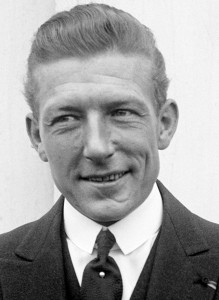
Charles Nungesser
Le Bourget features in several important events in the aviation history. The famous WWI fighter ace Charles Nungesser departed France from Le Bourget in his abortive flight on the L’Oiseau Blanc (The White Bird) to cross the Atlantic Ocean on 8 May 1927. Nungesser (1892 – 1927) shot down 43 enemy aircraft throughout World War I becoming France’s third deadliest pilot. He became the model for the dashing, debonair fighter pilot with a penchant for rushing off to Paris for the finer things in life – wine and women, and was known to turn up for a sortie still wearing his tuxedo from the previous night and occasionally with a young lady still clinging to his arm. He was wounded numerous times and by 1918 Nungesser often needed to be assisted into his cockpit. His injuries included a bullet wound to the mouth. On his fateful flight to America Nungesser’s plane was last seen in Ireland and it is thought that he crashed in the Atlantic Ocean.
Two weeks later Le Bourget was the scene of another historical event, American pilot Charles Lindbergh arrived having flown non-stop from New York’s Long Island to Le Bourget on the Spirit of St. Lewis, arriving at the airfield on 21 May 1927. Charles Lindbergh instantly became an American hero and promoted aviation throughout the United States. His high profile led to the kidnapping and murder of his infant son in March 1932, in what the media dubbed “the crime of the century”. Lindbergh flew 50 combat missions in the Pacific during World War II as a civilian contractor.
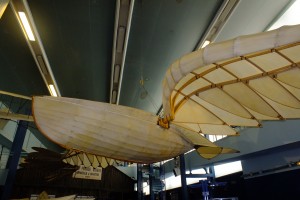
A 19th century aircraft designed using the concept of a flying boat
The museum at Le Bourget has lifelike models of some of the first aeroplane designs from the 19th century with light wooden frames and scalloped canvas wings and then large collections of actual planes from the world wars. Another wing of the airport has a section devoted to space flight, which includes some of the first satellites – rather similar to giant sized cannon-balls and models of contemporary communication satellites with solar panels and aerials and all the rest of the exciting paraphernalia.
The museum continues to trace the development of flight with a section on space flight, including a brief biography of the founder of the Soviet Space programme Sergey Pavlovich Korolev (1907-1966) who was largely responsible for the early success of the programme with Sputnik I in 1957 and was followed up with manned flights by Yury Gagarin (1934-1968) on 12 April 1961 and later Valentina Tereshkova (1937) on 16 February 1962.
The exhibition also includes information on an agreement between the Soviet Union and France on mutual space exploration, leading to the flight of the first Western European in space, French astronaut Jean-Loupe Chrétien in 1982.
A brief history of flight
Aviation is perhaps one of the most remarkable achievements of humanity and has been attempted for centuries. The Greek story of Icarus is a description of perhaps one of the earliest ill-fated attempts to fly. In the early 11th century an Englishman Elimer attempted to fly and after an awkward fall explained his failure by claiming that he had forgotten to put on tail feathers. Ingenious as this excuse may have been, it had already been used some centuries earlier by Arabic scholar Ben Firnas in about 875 AD. Other attempts to fly included using kites which were first invented by the Chinese and used for festivals and at times of war to signal messages. The Chinese started using kites from between the sixth to the second century BC and would use them to raise lanterns and other objects. At some stage they contrived the idea of using them to hoist small animals and then in about the fourth century AD added humans to the payload. As such entertainment was considered dangerous the “pilots” were usually convicts or prisoners of war. Marco Polo describes witnessing one such flight in the 13th century.
While Leonardo da Vinci designed various flying machines it was not until the 19th century that people started having some limited success in creating gliders and aeroplanes. English scientist George Cayley (1773-1857) came up with the basic scientific principles of aerodynamics in 1804 and realising that a steam engine would be too heavy to provide necessary propulsion attempted to use gunpowder to create a solid fuel jet engine. Although his attempts to create a powered aeroplane failed, his 1804 glider did succeed in flying. In 1838 another Englishman, William Henson (1812-1888) started work on a flying contraption which led to the development of a light weight steam engine and was the first to design a screw-type propeller. This design captured the public’s imagine and became the model for numerous designs throughout the second half of the 19th century. Other designs were less fortunate, one design which could be compared to modern supersonic aircraft, appears to have been modelled more on paper darts that school children like to throw at teachers when their backs are turned.
In 1856 the first soaring glider was invented by Frenchman, Jean-Marie Le Bris and led to a successful flight in 1868 of 30 metres. However, the first successful glider flight was performed by A Mouillard in 1865 whose short flight was the catalyst for a series of glider designs which took aircraft design out of the hands of scientists into those of hobbyist glider pilots who attempted to motorise their gliders. These earlier gliders were popularised by German entrepreneur Otto Lilienthal (23 May 1848 – 10 August 1896), in the 1890s, who was the first to mass produce gliders. In 1896 this talented businessman and designer stalled when gliding at the height of 15 metres and broke his neck in the fall. Before his death Lilienthal had made over 2000 flights and had climbed to over 250 metres in some of them. Some flights had lasted dozens of seconds.
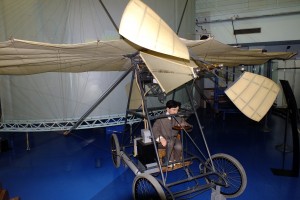
A late 19th century prototype aeroplane. The propeller is made from canvas
However, research on aeroplanes was not static, two designs from the period were particularly interesting. Hiram Maxim (1840-1916) an American engineer who moved to England and designed the Maxim Gun became interested in the possibility of flight. Instead of wasting his time with modelling birds, Maxim focused on aerodynamics and basing his work on some crude wind tunnels built in the 1870s constructed his own wind tunnel. Having got sufficient data he began constructing his aircraft in 1891 and completed it in 1894. Propelled by steam engine it weighed over 3.5 tonnes and had a horizontal surface area of 372 square metres. The two engines were also designed to create additional horizontal surfaces and were capable of generating 180 hp each. Testing of Maxim’s design took place in 1894 with the aircraft tethered to the ground. Although eyewitness accounts differ, it seems that the aircraft did take off but Maxim lost interest in the design, although he did continue work on a gyroscope which would have been used for aircraft stability.
Another innovative design was by French engineer Clément Ader (1841-1925). Instead of taking a scientific approach Adler decided to try something completely different. Whereas most early aircraft designs were modelled on birds, his was modelled on bats. Ader’s creation Eol used silk stretched over bamboo struts for wings. The plane was to be controlled by using four different wing shapes, copied off the bats he kept in open air cages next to his workship. Ader’s invention did take off in 1890 reaching a height of about 20 cm and managing to flutter like an injured bird some 50 metres. Ader spent 250,000 francs on his invention and was able to attract military funding for his next inventions which were canned in 1897 after an abortive test flight.
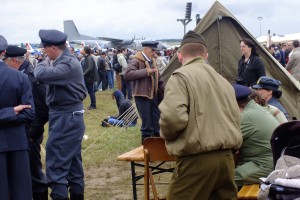
Pilots of WWI aircraft play the part not only in the air but on the ground too
Although credit goes to the Wright Brothers for the first successfully publicised powered flight, the two Brother’s failed to capitalise on their invention. Previous failures for heavier than air vehicles had left the public jaundiced and the brothers’ first flight in 1903 coincided with new developments in zeppelins in Europe, meaning that the brothers’ first notes were initially ignored. On 29 September 1905, the Wright brothers achieved a 20 minute flight on Flyer III. Believing to have a viable aircraft which they could sell to the government the two brothers ceased flights after they started attracting crowds. Negotiations with the government were slow and in the meantime European inventors took advantage of reports from the United States to alter their designs and eventually came up with models which were better than the Wright brothers’ prototype. Over the next six years aircraft developed from outlandish flying contraptions to vehicles which changed the nature of warfare, becoming the well known monoplanes and biplanes flown in World War I.
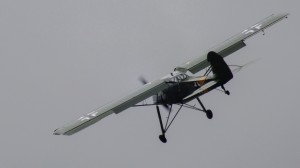 The First World War led to extensive development in aircraft. Prior to the war the speed of planes had hovered around 100 km/h (although the Deperdussin, a French plane built in 1913 was capable of doing 200 km/h). By the end of the war the leading fighters all flew at 200 km/h.
The First World War led to extensive development in aircraft. Prior to the war the speed of planes had hovered around 100 km/h (although the Deperdussin, a French plane built in 1913 was capable of doing 200 km/h). By the end of the war the leading fighters all flew at 200 km/h.
Following the war aircraft design was neglected since over 85,000 aircraft had survived the war and were sold off creating a glut in the market and little incentive to carry out further development work for another decade. In the late 1920s and early 1930s research focused on creating passenger planes and postal planes. The consequence of this research was demonstrated in 1935 when a Nazi political delegation flew to the Soviet Union and the fighter escort was unable to keep up with the passenger aircraft.
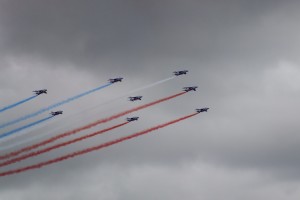
The French Airforce put on a concluding display to show how far flight has come in the past century
Research in the mid to late 1930s took aircraft development to the next level and it is in aircraft of the later 1930s that we begin to see aircraft whose design features begin to look familiar to us today. Additional developments during the Second World War led to the development of what we can term modern aircraft, which do not vastly differ from the aeroplanes we travel in today. The post war challenge focused on extremely high-tech military aircraft and space flight.
Be sure to like Intrepid Adventure on Facebook and check out Peter Campbell’s latest books on Amazon.com.
Copyright © Peter Campbell 2014, www.intrepid-adventure.com

